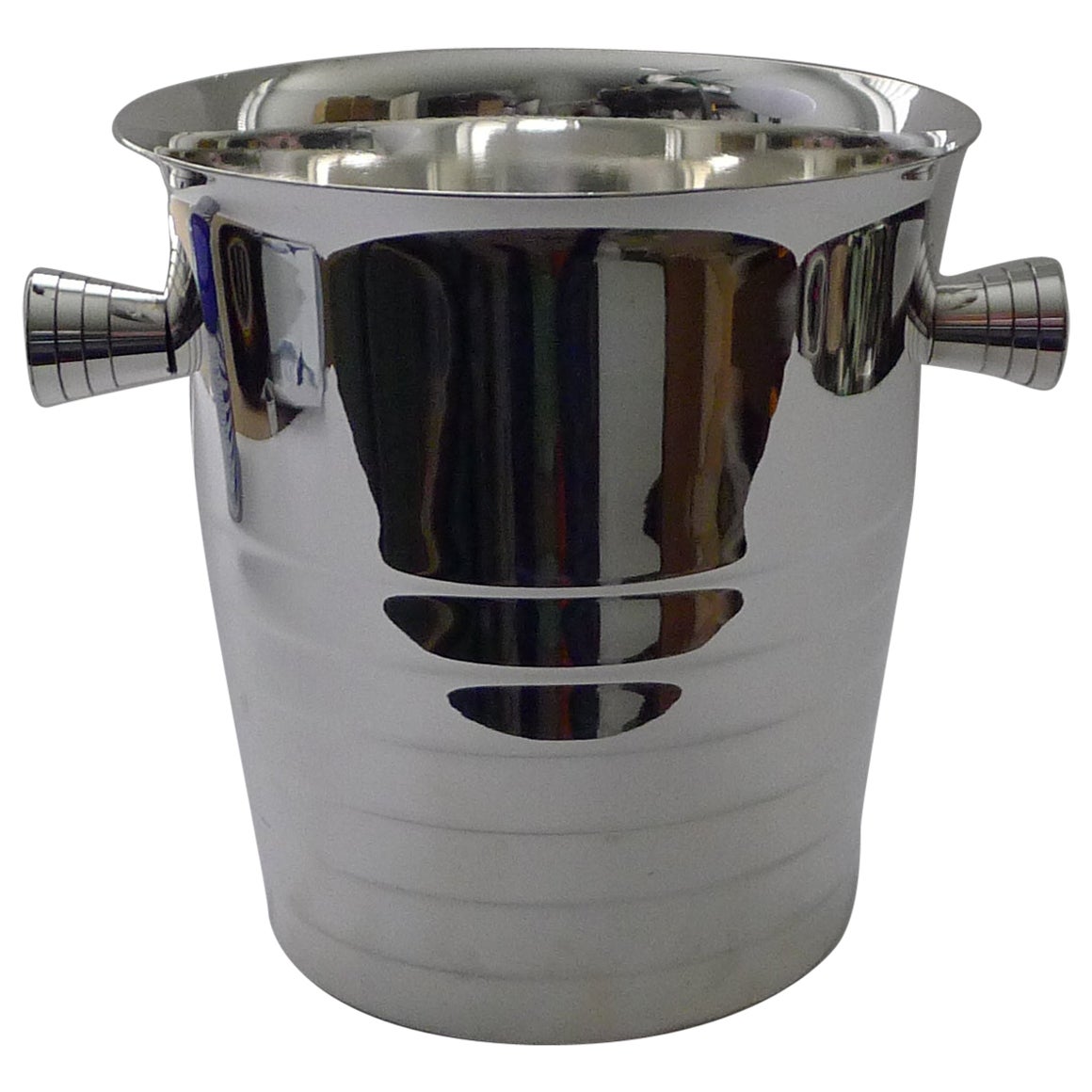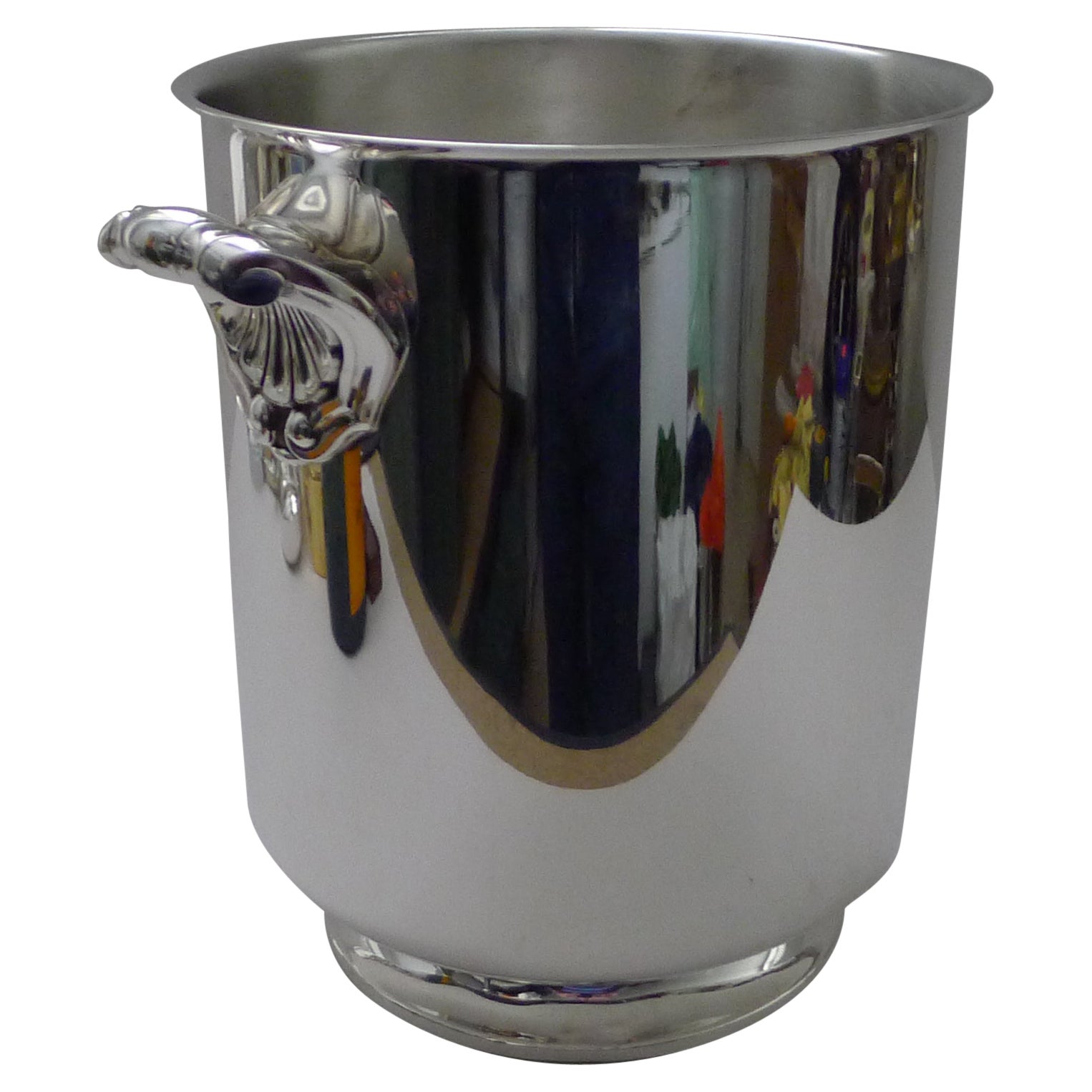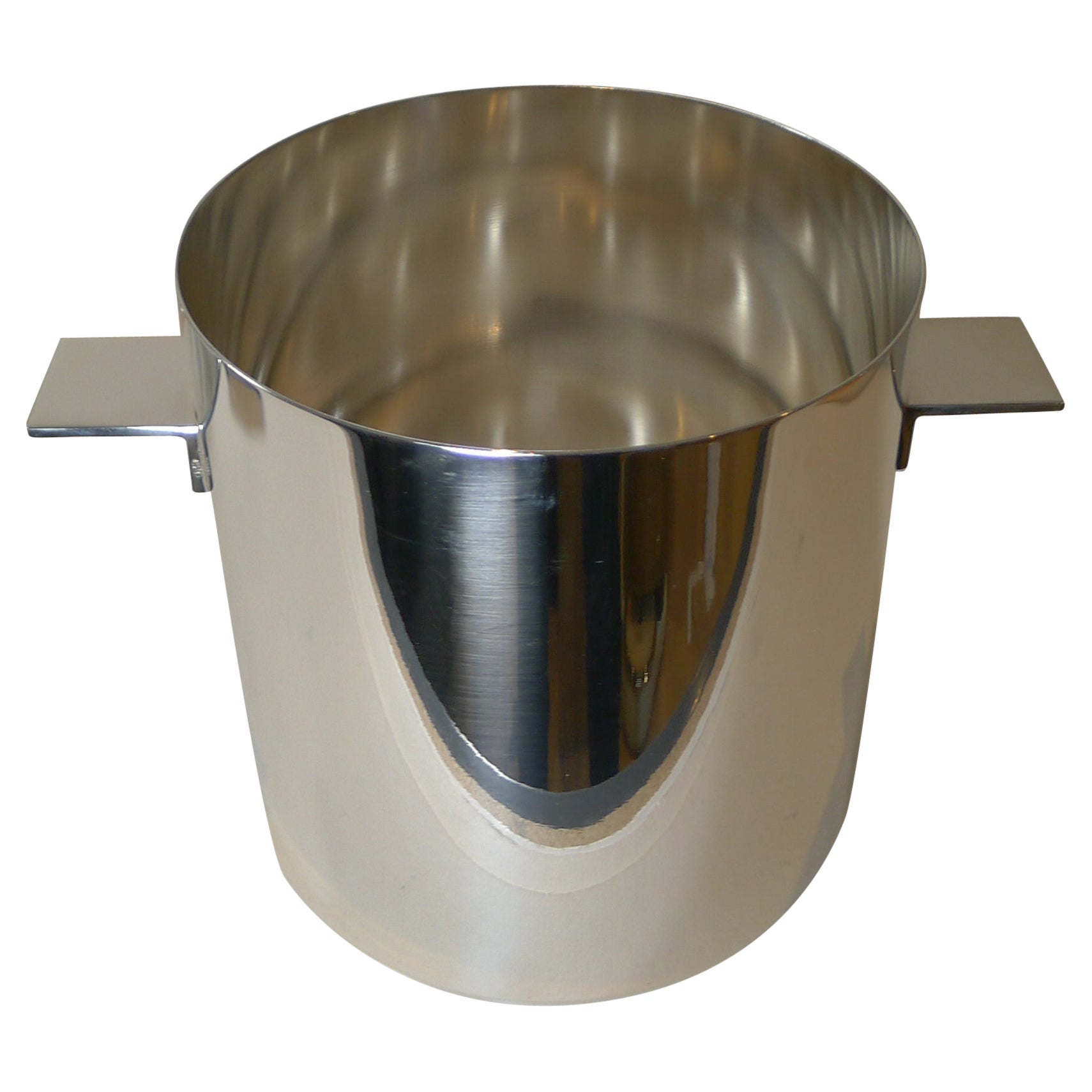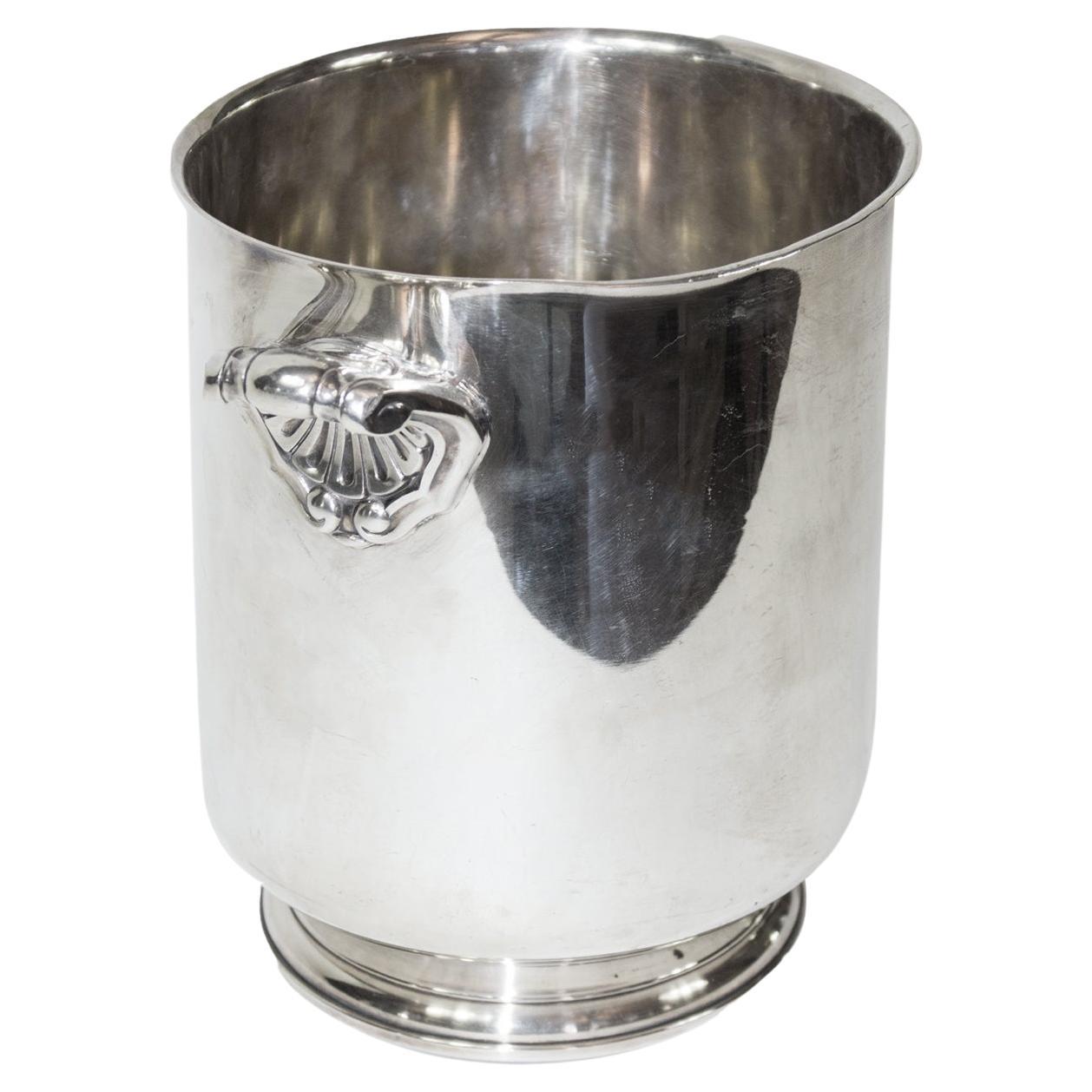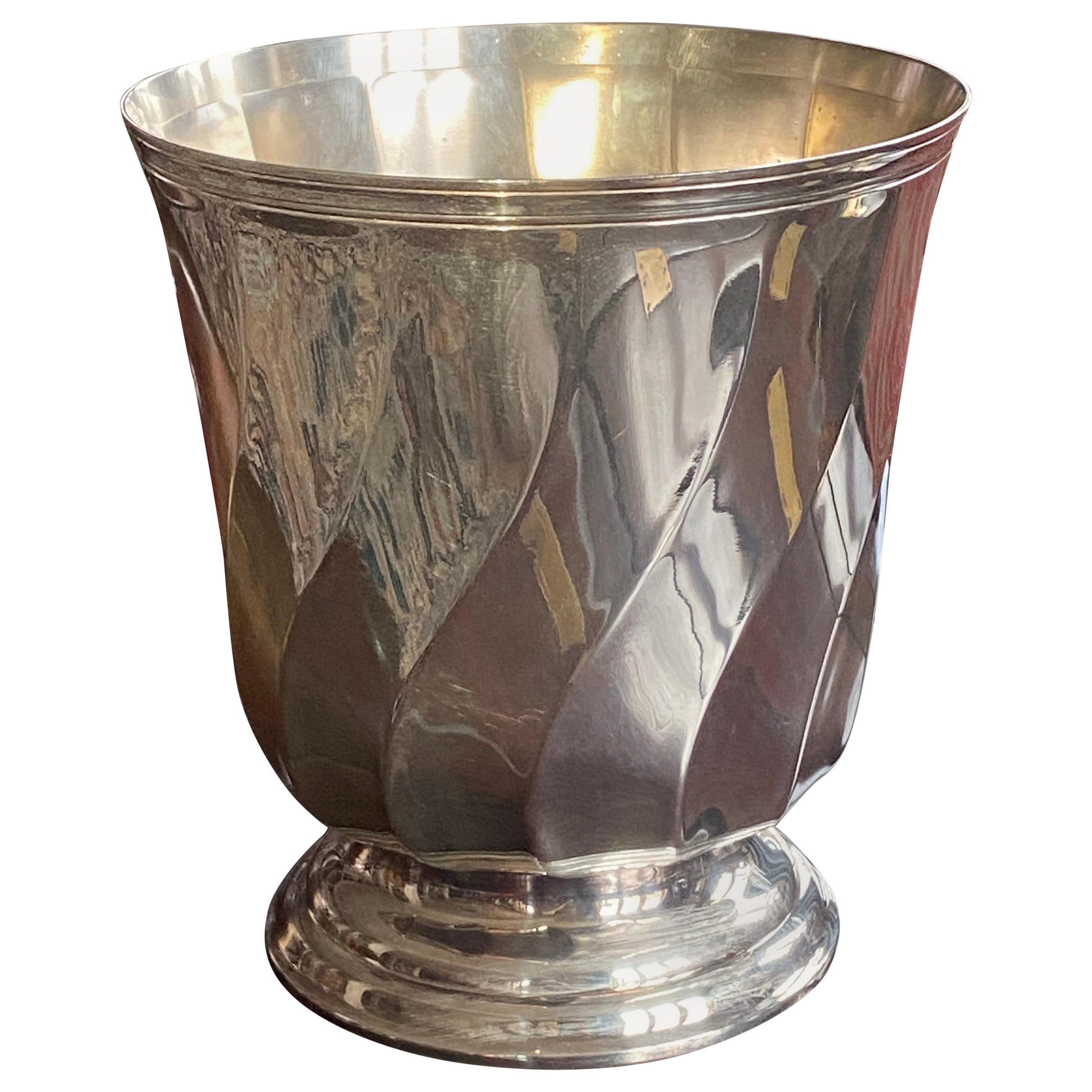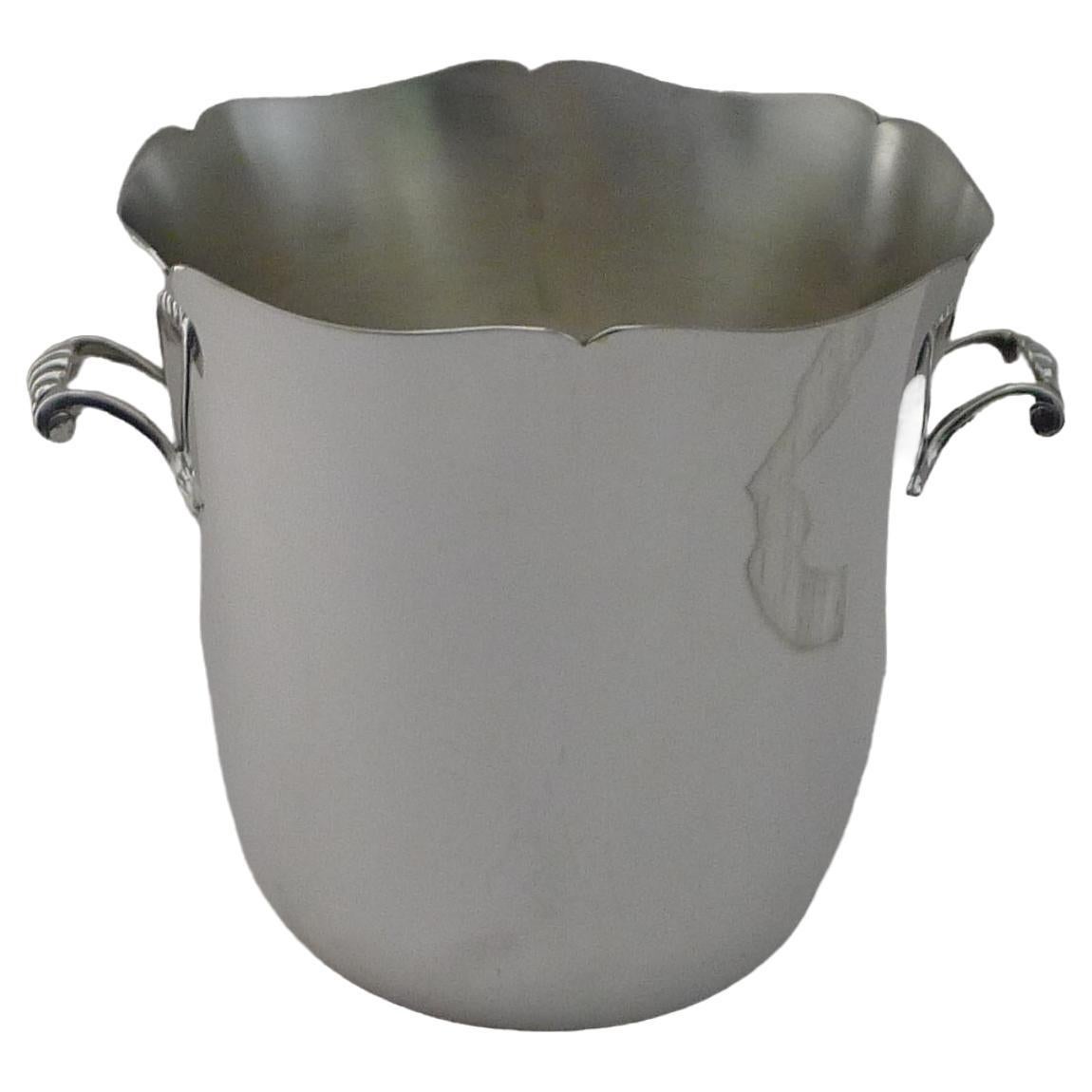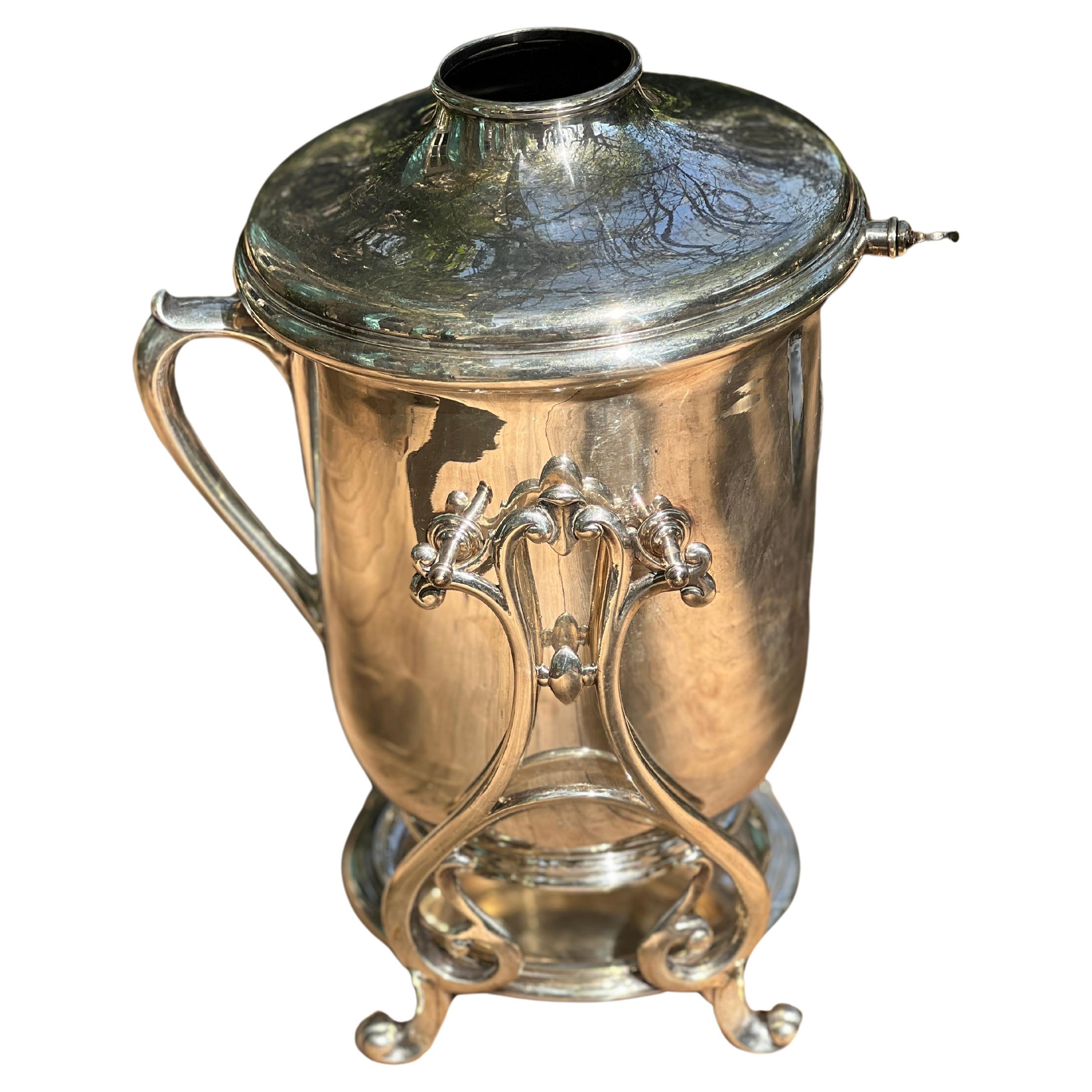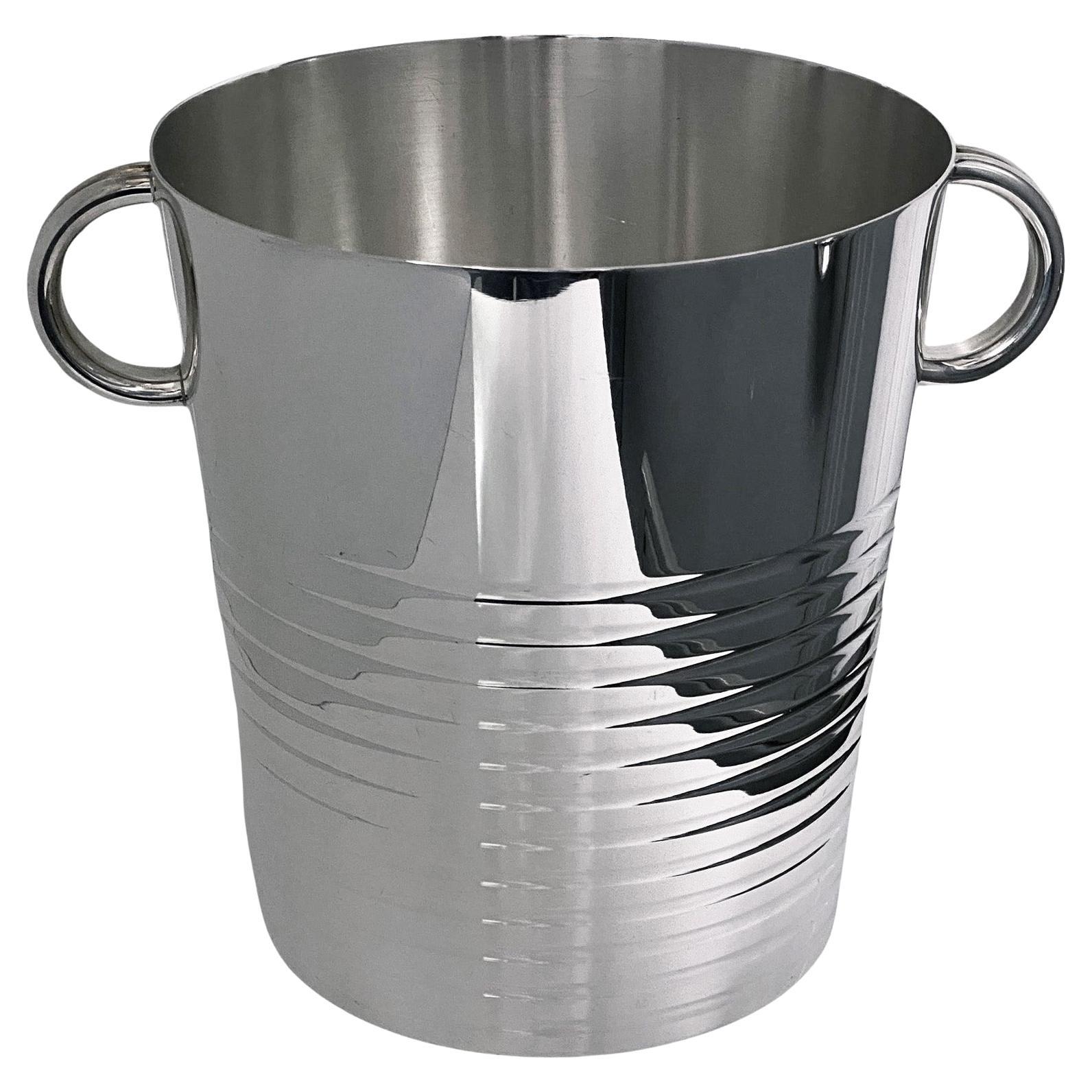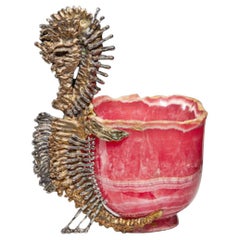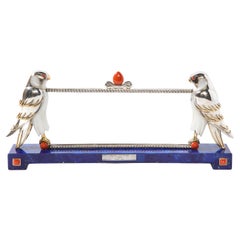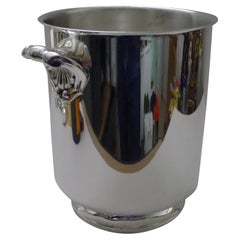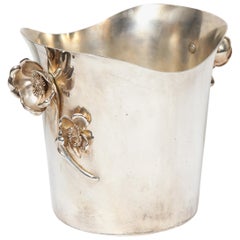
Christofle Paris Silver Plated "Anemone" Champagne Bucket / Wine Cooler
View Similar Items
Christofle Paris Silver Plated "Anemone" Champagne Bucket / Wine Cooler
About the Item
- Creator:Christofle (Maker)
- Dimensions:Height: 9.5 in (24.13 cm)Diameter: 11.5 in (29.21 cm)
- Style:Mid-Century Modern (Of the Period)
- Materials and Techniques:
- Place of Origin:
- Period:
- Date of Manufacture:21st Century
- Condition:Wear consistent with age and use.
- Seller Location:New York, NY
- Reference Number:1stDibs: LU1798215921962
Christofle
Although he started his career as a jeweler in 1830 — after apprenticing with his copper jeweler brother-in-law years earlier — Charles Christofle (1805–63) recognized that Second Empire France had an untapped audience for luxury silverware and tableware.
Gold and silver gilt had been the high-end standard in the 18th century, yet society after the Industrial Revolution demanded a more affordable, but still refined, approach. So in the 1840s, Christofle cornered the market on electrolytic gilding and silver plating, dominating the hold on patents in the country for over a decade. His work soon attracted the attention of Louis-Philippe I and then Napoleon III, under whom he was named Fournisseur de l’Empereur, cementing the prestige of his brand.
While Christofle created decadent centerpieces and tableware for the French palaces — as well as prominent clients like the Orient Express — the company’s electroplating of silverware that was far less expensive than that made by silversmiths attained widespread popularity. At a time when many who could not afford gold or silver still used wooden utensils, Christofle was a game changer for at-home dining. An appearance at the 1893 World’s Columbian Exposition in Chicago furthered the company’s reach to American consumers who would soon rival the manufacturer’s European clientele.
The 20th century saw Christofle adapting to changing tastes in its offerings, such as the Aria collection, which debuted in 1985 with column-like lines on its flatware designed by Bernard Yot, and the playful egg-shaped silverware container introduced in 2015 that opens to reveal a full flatware set. The company also now sells barware, home accessories and even jewelry, harkening back to its roots. Now almost two centuries old, Christofle maintains its reputation as a leading flatware and silverware company under the ownership of the Chalhoub group, its utensils gracing tables in homes, hotels and restaurants all over the world.
Shop authentic Christofle serveware, ceramics, decorative objects and more on 1stDibs.
- Important Ormolu and Silvered Bronze Figural Wine Cooler, Possibly Russian, 1860By Pavel SazikovLocated in New York, NYImportant ormolu and silvered bronze figural wine cooler, possibly Russian, 1860 Gilt and silvered bronze wine cooler. Modeled with two Russian polar bears at the handles and with a young gunmen holding a rifle seated with a sea otter...Category
Antique 19th Century Russian Wine Coolers
MaterialsBronze
- Chaumet Paris, a French Silver-Gilt Seahorse Mounted Rhodochrosite CupBy ChaumetLocated in New York, NYChaumet Paris, A French Silver-Gilt Seahorse Mounted Rhodochrosite cup Circa 1980. An exceptional object A quadrangular cut cup in rhodochrosite and the handle made of a sea...Category
Late 20th Century French Brutalist Mounted Objects
MaterialsSterling Silver
- Mellerio Paris, a Silver, Gold, Lapis Lazuli, Coral, and Hardstone Picture FrameBy MellerioLocated in New York, NYMellerio Paris, a large silver, gold, lapis lazuli, coral, and hardstone picture photo frame with two falcons. France, circa 2000 The frame resting on a lapis lazuli base with squa...Category
21st Century and Contemporary French Picture Frames
MaterialsCoral, Lapis Lazuli, Silver
- Mellerio Paris, A French Gold, Diamonds, Silver, and Smoky Quartz Carved HorseBy MellerioLocated in New York, NYMellerio Paris, A French Gold, Diamonds, Silver-Gilt, Rock-Crystal, Jade, Mother-Of-Pearl and Smoky Quartz, Carved Horse Sculpture, Jeweled Mounted Object. An extremely rare and unique, one of a kind French gold, diamonds, Silver-gilt, rock-crystal, jade, obsidian, mother-of-pearl, and smoky quartz carved jeweled sculpture "CHEVAUX DE LEGENDE", "A Legendary Horse" by Mellerio, Paris, circa 1991. Sitting on black obsidian base, the solid rock-crystal slab is finely applied with a carved smoky -quartz and jade horse with a harness mounted in 18k gold, brilliant -cut diamonds, rubies, turquoise, and amethyst chains and pendants. The top columns adorned with 18k gold and brilliant cut diamond pendants, the bottom with gold and mother of pearl plaques. The obsidian base with a plaque engraved: CHEVAUX DE LEGENDE" / N° 05 / MELLERIO DITS MELLER / PARIS / 5003 D The piece is in excellent condition and comes with a custom made wood case made for transport. It's very elegant and has French hallmarks throughout. A truly magnificent piece. Measures 10.5" high x 8.5" wide x 4" deep Founded in France in 1613 by the descendants of Italian immigrants from the Vigezzo Valley in the north of Italy, Mellerio is one of the oldest jewellery houses in Europe. The family business soon attracted the attention of the Royal Court and Marie Antoinette herself reportedly purchased a precious bracelet featuring 7 cameos surrounded by rubies in 1780. Later on, in the 19th century, Mellerio became the official supplier of the French Royal family and the Court of Netherland. Mellerio creates many jewellery items, all set with rare gems such as peridots, amethysts, aquamarines, citrines and topaz, applying for a patent, the flexible stem, a very supple and light jewellery mechanism. Mellerio remains also well known for their spectacular series of Art Nouveau jewels, created at the beginning of the 20th century, as well as for the creation of trophies rewarding some of the greatest footfall and tennis players of history. In 1993, the jewellery house launched their first watch collection. Today, Mellerio has stores in Paris, Japan and Hong Kong. July 14, 1789: this date is known throughout the world as the beginning of the French Revolution. According to a ledger belonging to House of Mellerio, this was also the day that the jeweler sold a golden key to the Comte de Coutance for 10 livres. This ledger, as well as inventories dating as far back as 1768, are the jeweler’s oldest archives. These archives have continued to grow over the years, as the House, established on rue de la Paix in Paris, still lives on today, still in the hands of the same family from Craveggia, in the North of Italy. The tumultuous history of the Mellerio family in France probably goes as far back as the Italian wars of the Renaissance, but the first official document proving their commercial activity in Paris dates back to 1613. This document is the famous royal warrant awarded by Marie de Medici to a number of Italian families established along the rue des Lombards, including the Mellerios, allowing them to sell “small jewelery items”, therefore granting them a small exception to the traditional monopoly enjoyed by Parisian jewelers. At that time, powerful corporations regulated the operations and customs of Parisian business, but thanks to this exceptional warrant, the Mellerios managed to escape the confines of this framework. Today, this wax-sealed document is kept at the city hall of Craveggia. From 1613 to the Revolution, the Mellerios lived between France and Italy. The corporations tried many times to put an end to their trade privileges, but all in vain, as a dynasty of sovereigns renewed the warrant. Always marrying and often retiring in Craveggia, the Mellerios continued to maintain their jewelry business in Paris. At first, they did this without a shop. Wearing backpacks (wooden boxes divided into small compartments where jewels were kept), they would tour town fairs around Paris and royal castles. This is how Jean-Baptiste Mellerio (1765-1850) is said to have sold a bracelet set with rubies and Antique cameos to Marie-Antoinette, which still exists today. Many elements seem to prove the veracity of this anecdote. The queen was particularly fond of cameos, which cover the entire background of her famous jewelry cabinet, and ruby was her favorite stone after diamond. The famous bracelet, reacquired a few years ago by the House of Mellerio, is indeed an 18th century jewel, set with antique cameos representing the profiles of Roman emperors. Two branches of the family were operating in Paris during this time, under the reign of Louis XVI: that of Jean-François (1746-1828), the paternal ancestor of the current Mellerios, and that of Jean-Baptiste (1765-1850). The French Revolution forced them to return to Italy. However, both Jean-Baptiste and François Mellerio (1772-1843), who was the son of Jean-François, were eventually able to return to Paris after the founding of the Consulate. Jean-Baptiste opened a shop at the Iron Crown of rue Vivienne, and François opened his at the Palais des Tuileries, rue du Coq Saint-Honoré. His well-organized order books give an idea of his high-ranking clientele during the “Old Regime”, among which were the Comte and Comtesse Octave de Segur, the Marquise (later Duchess) de Tourzel, former governess of the royal children, and her daughter, the Comtesse de Bearn, the Craufurds -who organized the flight to Varennes, the Duc and Duchess de Gramont, the Comtesse de Boigne, and Madame de Souza, Talleyrand’s mistress. We also see the names of the imperial family: Empress Josephine, the Queen of Holland, Princess Elisa, Caroline and Pauline. At that time, the House of Mellerio specialized, among other things, in the trade of antique cameos, a newly fashionable genre of jewel that captured the imagination of all the princesses and noble women of the time. The years of the Restauration and July Monarchy were among the most glorious. The Bourbons were back on the throne, and the clientele of the House of Mellerio had regained its former wealth. Mellerio supplied Louis-Philippe, Duke of Orléans, as well as his mother, wife and sister, with sumptuous jewels, including a set of emeralds made piece by piece, while the Duke of Bourbon, last prince of the House of Condé, offered diamonds to his mistress, the scheming Baronne de Feucheres, and Monsieur de LaFayette also bought cameos for one of his granddaughters. For the first time, Mellerio ventured into the world of arts in 1815, when Carlotta Grisi, a famous dancer who created Giselle, as well as an actress named Rachel, bought jewels at the Mellerio store on rue de la Paix. 1848 marked a new turning point. France once again became a Republic. François Mellerio handed the company over to his son, Jean, and the latter decided to travel to Spain to build a new clientele. He later became one of the jewelers of the royal family, and met Eugénie de Montijo, who remained a faithful client when she became empress of the French people. The Imperial years were lavish. During the Second Empire, Paris was a pageant of crinoline dresses designed by Worth, while jewels by Mellerio, Worth’s neighbour on the rue de la Paix, adorned the noble women of the Tuileries court. The Empress bought pearls. Mathilde Bonaparte...Category
20th Century French Mounted Objects
MaterialsJade, Quartz, Rock Crystal, Gold, Silver
- Mellerio Paris, A French Gold, Diamond, Silver-Gilt, Rock-Crystal, & Lapis HorseBy MellerioLocated in New York, NYMellerio Paris, A French Gold, Diamond, Silver-Gilt, Rock-Crystal, Obsidian & Lapis Horse An extremely rare and unique, one of a kind French gold, diamonds, Silver-gilt rock-crystal, obsidian and lapis lazuli jeweled sculpture "Bucéphale, Chevaux de légende", "Bucephalus, A Legendary Horse" by Mellerio, Paris, circa 1998. Sitting on black obsidian base, the solid rock crystal slab is finely applied with a lapis lazuli half-horse with harness mounted in 18k gold and brilliant cut diamonds, between two crystal and lapis lazuli columns adorned with gold and diamonds, insert with 7 ruby cabochons and 1 emerald cabochon, the obsidian base with a plaque engraved: CHEVAUX DE LEGENDE / MELLERIO DITS MELLER / PARIS / 5029 DIV Bucephalus (c355-326 BC) is among the most famous horses in history, and it was said that this he could not be tamed. The young Alexander the Great, of course, tamed him – and went on to ride his beloved equine companion for many years and into many battles. The piece is in excellent condition and comes with a custom made wood case made for transport. It's very elegant and has French hallmarks throughout. A truly magnificent piece. Measures 10" high x 9" wide x 4" deep Founded in France in 1613 by the descendants of Italian immigrants from the Vigezzo Valley in the north of Italy, Mellerio is one of the oldest jewellery houses in Europe. The family business soon attracted the attention of the Royal Court and Marie Antoinette herself reportedly purchased a precious bracelet featuring 7 cameos surrounded by rubies in 1780. Later on, in the 19th century, Mellerio became the official supplier of the French Royal family and the Court of Netherland. Mellerio creates many jewellery items, all set with rare gems such as peridots, amethysts, aquamarines, citrines and topaz, applying for a patent, the flexible stem, a very supple and light jewellery mechanism. Mellerio remains also well known for their spectacular series of Art Nouveau jewels, created at the beginning of the 20th century, as well as for the creation of trophies rewarding some of the greatest footfall and tennis players of history. In 1993, the jewellery house launched their first watch collection. Today, Mellerio has stores in Paris, Japan and Hong Kong. July 14, 1789: this date is known throughout the world as the beginning of the French Revolution. According to a ledger belonging to House of Mellerio, this was also the day that the jeweler sold a golden key to the Comte de Coutance for 10 livres. This ledger, as well as inventories dating as far back as 1768, are the jeweler’s oldest archives. These archives have continued to grow over the years, as the House, established on rue de la Paix in Paris, still lives on today, still in the hands of the same family from Craveggia, in the North of Italy. The tumultuous history of the Mellerio family in France probably goes as far back as the Italian wars of the Renaissance, but the first official document proving their commercial activity in Paris dates back to 1613. This document is the famous royal warrant awarded by Marie de Medici to a number of Italian families established along the rue des Lombards, including the Mellerios, allowing them to sell “small jewelery items”, therefore granting them a small exception to the traditional monopoly enjoyed by Parisian jewelers. At that time, powerful corporations regulated the operations and customs of Parisian business, but thanks to this exceptional warrant, the Mellerios managed to escape the confines of this framework. Today, this wax-sealed document is kept at the city hall of Craveggia. From 1613 to the Revolution, the Mellerios lived between France and Italy. The corporations tried many times to put an end to their trade privileges, but all in vain, as a dynasty of sovereigns renewed the warrant. Always marrying and often retiring in Craveggia, the Mellerios continued to maintain their jewelry business in Paris. At first, they did this without a shop. Wearing backpacks (wooden boxes divided into small compartments where jewels were kept), they would tour town fairs around Paris and royal castles. This is how Jean-Baptiste Mellerio (1765-1850) is said to have sold a bracelet set with rubies and Antique cameos to Marie-Antoinette, which still exists today. Many elements seem to prove the veracity of this anecdote. The queen was particularly fond of cameos, which cover the entire background of her famous jewelry cabinet, and ruby was her favorite stone after diamond. The famous bracelet, reacquired a few years ago by the House of Mellerio, is indeed an 18th century jewel, set with antique cameos representing the profiles of Roman emperors. Two branches of the family were operating in Paris during this time, under the reign of Louis XVI: that of Jean-François (1746-1828), the paternal ancestor of the current Mellerios, and that of Jean-Baptiste (1765-1850). The French Revolution forced them to return to Italy. However, both Jean-Baptiste and François Mellerio (1772-1843), who was the son of Jean-François, were eventually able to return to Paris after the founding of the Consulate. Jean-Baptiste opened a shop at the Iron Crown of rue Vivienne, and François opened his at the Palais des Tuileries, rue du Coq Saint-Honoré. His well-organized order books give an idea of his high-ranking clientele during the “Old Regime”, among which were the Comte and Comtesse Octave de Segur, the Marquise (later Duchess) de Tourzel, former governess of the royal children, and her daughter, the Comtesse de Bearn, the Craufurds -who organized the flight to Varennes, the Duc and Duchess de Gramont, the Comtesse de Boigne, and Madame de Souza, Talleyrand’s mistress. We also see the names of the imperial family: Empress Josephine, the Queen of Holland, Princess Elisa, Caroline and Pauline. At that time, the House of Mellerio specialized, among other things, in the trade of antique cameos, a newly fashionable genre of jewel that captured the imagination of all the princesses and noble women of the time. The years of the Restauration and July Monarchy were among the most glorious. The Bourbons were back on the throne, and the clientele of the House of Mellerio had regained its former wealth. Mellerio supplied Louis-Philippe, Duke of Orléans, as well as his mother, wife and sister, with sumptuous jewels, including a set of emeralds made piece by piece, while the Duke of Bourbon, last prince of the House of Condé, offered diamonds to his mistress, the scheming Baronne de Feucheres, and Monsieur de LaFayette also bought cameos for one of his granddaughters. For the first time, Mellerio ventured into the world of arts in 1815, when Carlotta Grisi, a famous dancer who created Giselle, as well as an actress named Rachel, bought jewels at the Mellerio store on rue de la Paix. 1848 marked a new turning point. France once again became a Republic. François Mellerio handed the company over to his son, Jean, and the latter decided to travel to Spain to build a new clientele. He later became one of the jewelers of the royal family, and met Eugénie de Montijo, who remained a faithful client when she became empress of the French people. The Imperial years were lavish. During the Second Empire, Paris was a pageant of crinoline dresses designed by Worth, while jewels by Mellerio, Worth’s neighbour on the rue de la Paix, adorned the noble women of the Tuileries court. The Empress bought pearls. Mathilde Bonaparte...Category
20th Century French Mounted Objects
MaterialsLapis Lazuli, Rock Crystal, Gold, Silver
- Monumental and Masterful Pair of French Paris Porcelain Hand-Painted VasesLocated in New York, NYA monumental and masterful pair of French Paris porcelain hand-painted vases, circa 1860. These museum quality vases are extremely fine quality....Category
Antique 19th Century French Rococo Vases
MaterialsPorcelain
- Christofle, Paris, Champagne Bucket / Wine Cooler, FolioBy ChristofleLocated in Bath, GBA fine and very smart champagne bucket / wine cooler made by the top-notch French silversmith, Christofle of Paris. The design is "Folio" made in the 1980s, a modernist design with a nod to the Art Deco era a design that is most fashionable today. Excellent condition and looking like it has rarely been used. Spanning 10" handle to handle x 8" x 8 1/8" tall. Just back from our silversmith's workshop where it has been professionally cleaned and polished, restoring it to it's former glory. Beginning in 1830, when Charles Christofle...Category
Vintage 1980s French Mid-Century Modern Wine Coolers
MaterialsSilver Plate
- Christofle Gallia Champagne Bucket / Wine Cooler - OrmessonBy ChristofleLocated in Bath, GBA stunning vintage champagne bucket in silver plate, a hefty quality piece by the famous French Orfevrerie Christofle of Paris. This design is c...Category
Vintage 1950s French Mid-Century Modern Wine Coolers
MaterialsSilver Plate
- Lino Sabatinni for Christofle, Paris, Windsor Champagne Bucket / Wine CoolerBy Lino Sabattini, ChristofleLocated in Bath, GBA magnificent, stylish and Modernist silver plated Champagne bucket designed by the world famous Lino Sabatinni, the preeminent figure in modern Italian silver and metalware design. ...Category
Mid-20th Century French Mid-Century Modern Barware
MaterialsSilver Plate
- Christofle, Paris, Gallia Champagne Bucket / Wine Cooler, Art Deco PeriodBy ChristofleLocated in Bath, GBA rarely found model with it's footed base and two very elegant scroll handles, this silver plated champagne bucket was made by the top-notch Parisian silver and goldsmith's, Orfèvre...Category
Vintage 1940s French Art Deco Barware
MaterialsSilver Plate
- Christofle Wine or Champagne Cooler Bucket, Model OrmessonBy ChristofleLocated in AMSTERDAM, NHVintage Christofle France silver plated wine or champagne cooler or ice bucket. A stunning vintage champagne bucket or cooler in silver plate, a hefty quality piece by the famous Fr...Category
Mid-20th Century French Mid-Century Modern Wine Coolers
MaterialsSilver Plate
- French Silver Plated Torsades Wine and Champagne Cooler by ChristofleBy ChristofleLocated in Sofia, BG21st Century French silver plated wine and champagne cooler model Torsades by Christofle in geometrical design. France, circa 1980Category
Late 20th Century French Wine Coolers
MaterialsSilver
